Football first aid kits play a crucial role in minimizing on-field injuries and ensuring the safety of players. Sufficient first aid equipment is essential in treating injuries on football fields. However, deficits in first aid on the field are still present in youth football. A study found that 84% of participating youth football teams had their own first aid kit, but the majority of them were insufficiently equipped. Coaches were responsible for using the first aid equipment in 60% of all youth teams.
Common football injuries include concussions, sprains, strains, fractures, and ligament damage. To effectively treat these injuries, it is important to have a well-stocked football first aid kit. This kit should include essential items such as wound dressings, bandages, plasters, tape, gloves, tweezers, scissors, wipes, ice packs, and a foil blanket.
In addition to prevention measures such as proper warm-ups and stretching, coaches should also receive education in first aid management. By having knowledgeable coaches on the field, immediate treatment and care can be provided to injured players, reducing the risk of further complications and promoting faster recovery.
Addressing the most common risks in football is crucial for player safety. Having the necessary first aid equipment readily available can help treat injuries quickly and effectively. Timely treatment is essential in preventing further harm and ensuring the well-being of players.
In conclusion, a well-equipped football first aid kit is vital in reducing on-field injuries and promoting player safety. By prioritizing proper first aid equipment and education for coaches, we can create a safer environment for football players and minimize the risks associated with the sport.
Insufficient First Aid Equipment in Youth Football
Despite being essential in treating injuries, first aid equipment in youth football often falls short, with many teams lacking the necessary supplies. A recent study conducted among youth football teams found that 84% of the participating teams had their own first aid kit. However, upon further evaluation, it was revealed that a majority of these kits were insufficiently equipped to handle common injuries that occur on the field.
Coaches were responsible for using the first aid equipment in 60% of all the youth teams surveyed. This highlights the critical role that coaches play in ensuring the safety and well-being of their players. It also raises concerns about the lack of training and education provided to coaches regarding the proper use of first aid equipment and management of injuries.
Common football injuries such as concussions, sprains, strains, fractures, and ligament damage require immediate attention and proper treatment. It is crucial for each youth football team to have a well-stocked first aid kit that includes essential items such as wound dressings, bandages, plasters, tape, gloves, tweezers, scissors, wipes, ice packs, and a foil blanket. These supplies can greatly aid in the immediate care of injuries and minimize the risk of further complications.
Addressing the deficits in first aid equipment in youth football is of utmost importance to ensure the safety and well-being of young athletes. By providing teams with the necessary supplies and ensuring coaches receive proper education on first aid management, we can create a safer environment for young football players and effectively address injuries that occur on the field.
| Item | Quantity |
|---|---|
| Wound dressings | 10 |
| Bandages | 15 |
| Plasters | 20 |
| Tape | 2 rolls |
| Gloves | 5 pairs |
| Tweezers | 1 |
| Scissors | 1 |
| Wipes | 10 |
| Ice packs | 4 |
| Foil blanket | 2 |
Common Football Injuries
Football players are susceptible to various injuries, ranging from concussions to fractures and ligament damage. These injuries can occur due to the physical nature of the sport, collision with other players, or sudden changes in direction during gameplay. It is crucial to understand these common football injuries and take preventive measures to minimize the risk of occurrence.
One of the most prevalent injuries in football is a concussion. This is a traumatic brain injury that can result from a blow to the head, causing temporary cognitive impairment and a range of symptoms. Another common injury is sprains, which involve the stretching or tearing of ligaments that support the joints. Strains, on the other hand, refer to the tearing of muscles or tendons.
Fractures, such as broken bones, can occur from the impact of a collision or a fall during gameplay. Ligament damage, particularly to the anterior cruciate ligament (ACL), is also common in football. This can happen when players change direction suddenly or make sharp turns, putting excessive stress on the ligaments in the knee.
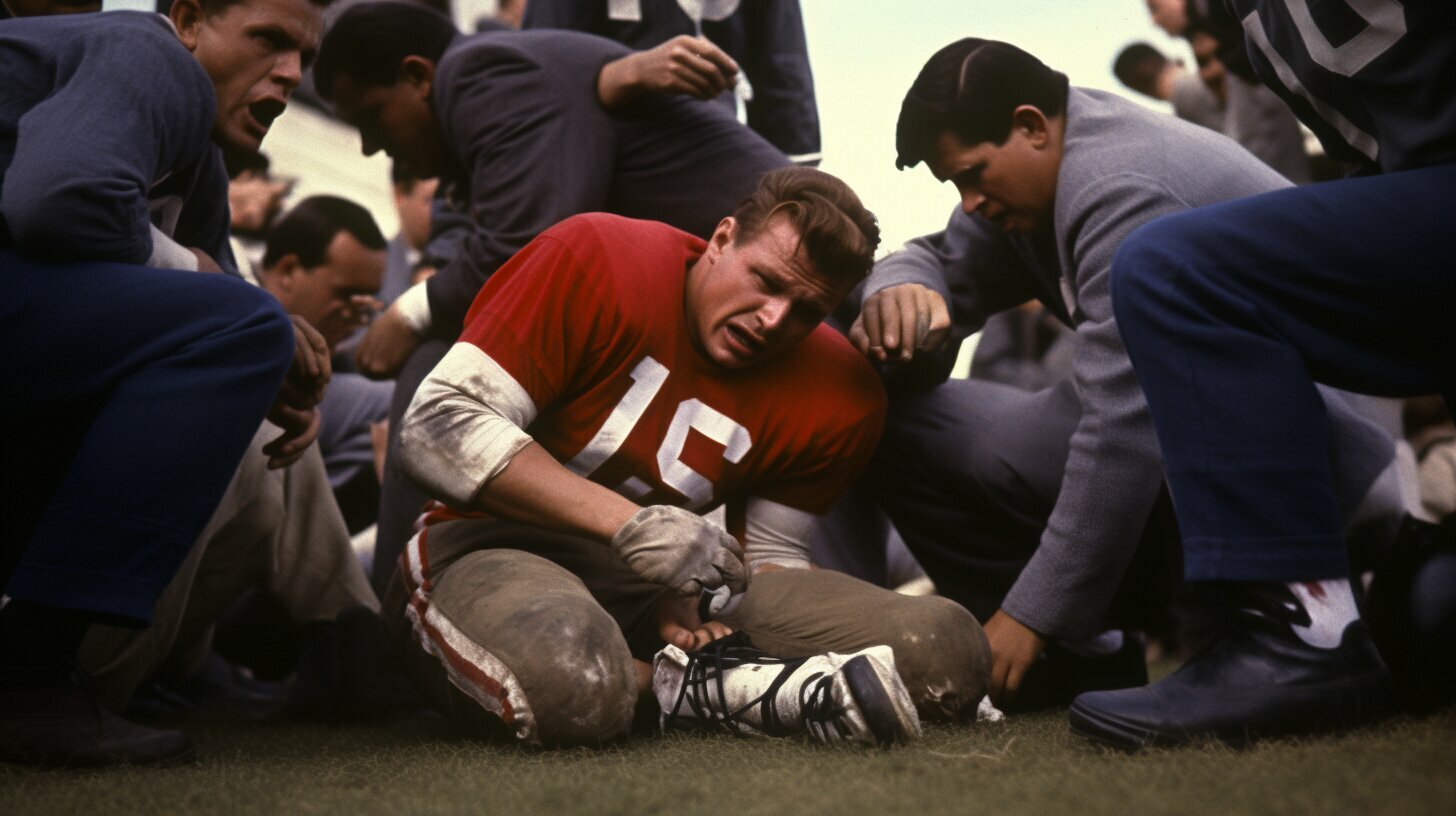
Prevention and timely treatment are key to reducing the impact of these injuries. Football safety measures, such as wearing protective gear and maintaining proper technique, can lower the risk of injury. Additionally, warm-up exercises and stretching before games and practices help prepare the muscles and joints, reducing the likelihood of strains and sprains.
It is essential to have a well-stocked football first aid kit on hand to address injuries quickly and effectively. This kit should include items such as wound dressings, bandages, plasters, tape, gloves, tweezers, scissors, wipes, ice packs, and a foil blanket. Proper education in first aid management for coaches is also crucial to ensure immediate and appropriate care for injured players.
Common Football Injuries
| Injury Type | Description |
|---|---|
| Concussion | Traumatic brain injury resulting from a blow to the head |
| Sprains | Stretching or tearing of ligaments supporting the joints |
| Strains | Tearing of muscles or tendons |
| Fractures | Broken bones from impact or falls |
| Ligament Damage | Tearing of ligaments, particularly the ACL, from sudden movements |
Components of a Well-Stocked Football First Aid Kit
A properly stocked football first aid kit should include essential items such as wound dressings, bandages, and gloves. These items are crucial in providing immediate care to injured players on the field. Wound dressings, such as sterile gauze pads, are necessary to cover and protect open wounds to prevent infection. Bandages, both adhesive and elastic, are essential for securing dressings in place and providing support for sprains and strains. Additionally, gloves are vital for protecting both the player and the first aider from potential contamination.
Aside from the basic supplies, a well-equipped first aid kit should also include additional items that can assist in injury treatment. Tweezers are useful for removing splinters or foreign objects, while scissors can be used to cut clothing or tape. Antiseptic wipes are crucial for cleaning wounds and preventing infection. Ice packs can help reduce swelling and alleviate pain, while a foil blanket is useful in providing warmth and comfort in extreme weather conditions.
To ensure proper organization and easy access to the supplies, it is recommended to store them in a durable and waterproof container. This will protect the contents from damage and keep them ready for use at any time. Regularly check the expiration dates of the supplies and replenish them as needed. It is also important to regularly review and update the contents of the first aid kit to ensure it remains comprehensive and up-to-date.
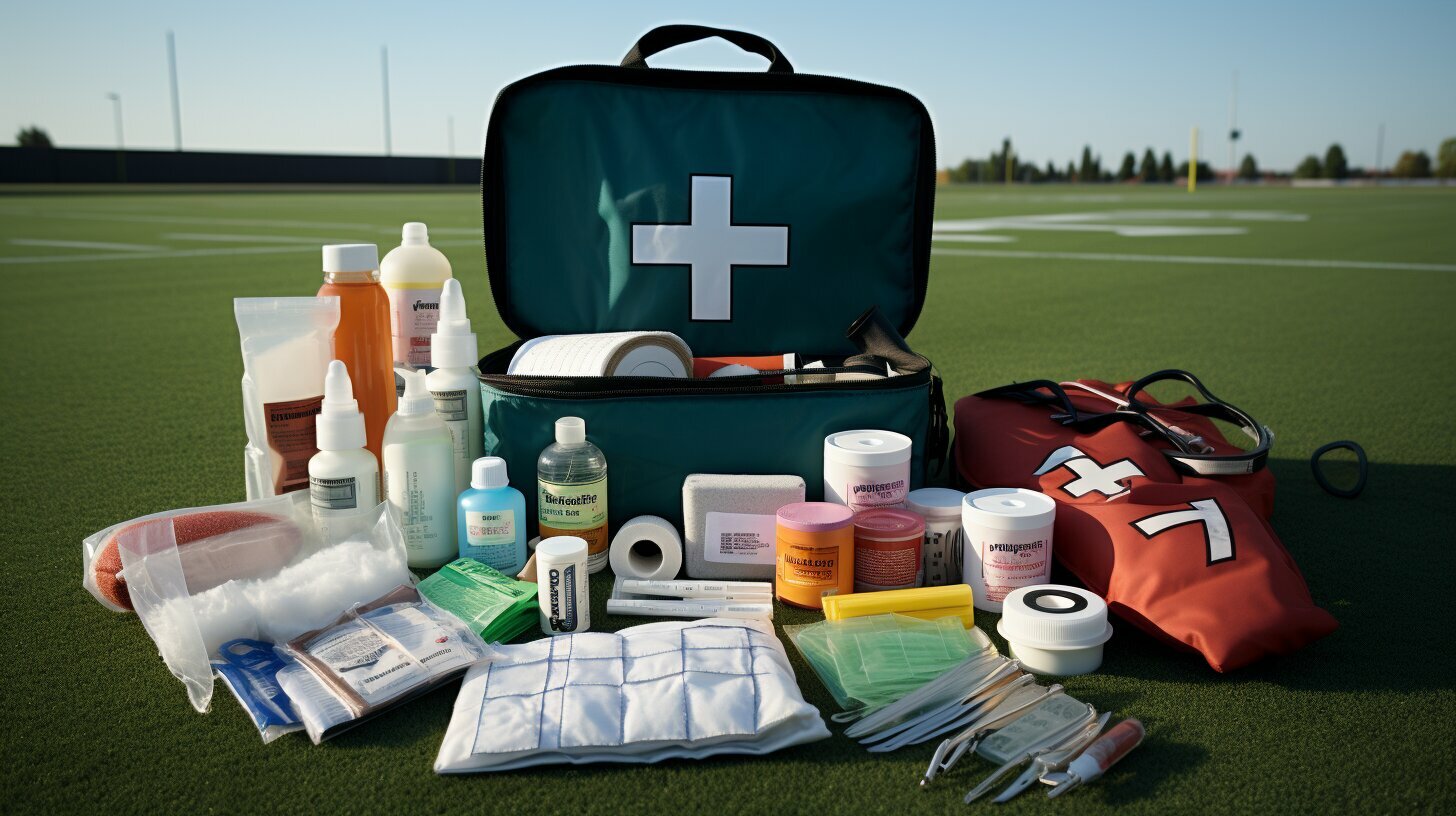
| Essential Items | Additional Items |
|---|---|
| Wound dressings (sterile gauze pads) | Tweezers |
| Bandages (adhesive and elastic) | Scissors |
| Gloves | Antiseptic wipes |
| Ice packs | |
| Foil blanket |
Importance of First Aid Education for Coaches
Coaches with adequate first aid education play a vital role in providing timely and effective care for injured football players. In the fast-paced and physically demanding sport of football, injuries can occur at any moment. It is crucial for coaches to be trained in first aid management to ensure the safety and well-being of their players.
According to a study conducted among youth football teams, it was found that a majority of teams had their own first aid kit, but many of them were insufficiently equipped. In these cases, coaches were responsible for utilizing the first aid equipment. With proper education, coaches can have the knowledge and skills to use the available resources effectively and provide immediate care when injuries occur.
Common football injuries such as concussions, sprains, strains, fractures, and ligament damage require prompt attention and appropriate treatment. Coaches who have received first aid education can quickly assess the severity of an injury, apply necessary first aid techniques, and make informed decisions on whether further medical assistance is required.
Furthermore, first aid education for coaches extends beyond just on-field injury care. It also includes preventive measures and risk management. Coaches who are well-versed in first aid can implement strategies to prevent injuries, such as teaching proper warm-up and stretching techniques, ensuring the use of protective equipment, and promoting safe playing practices.
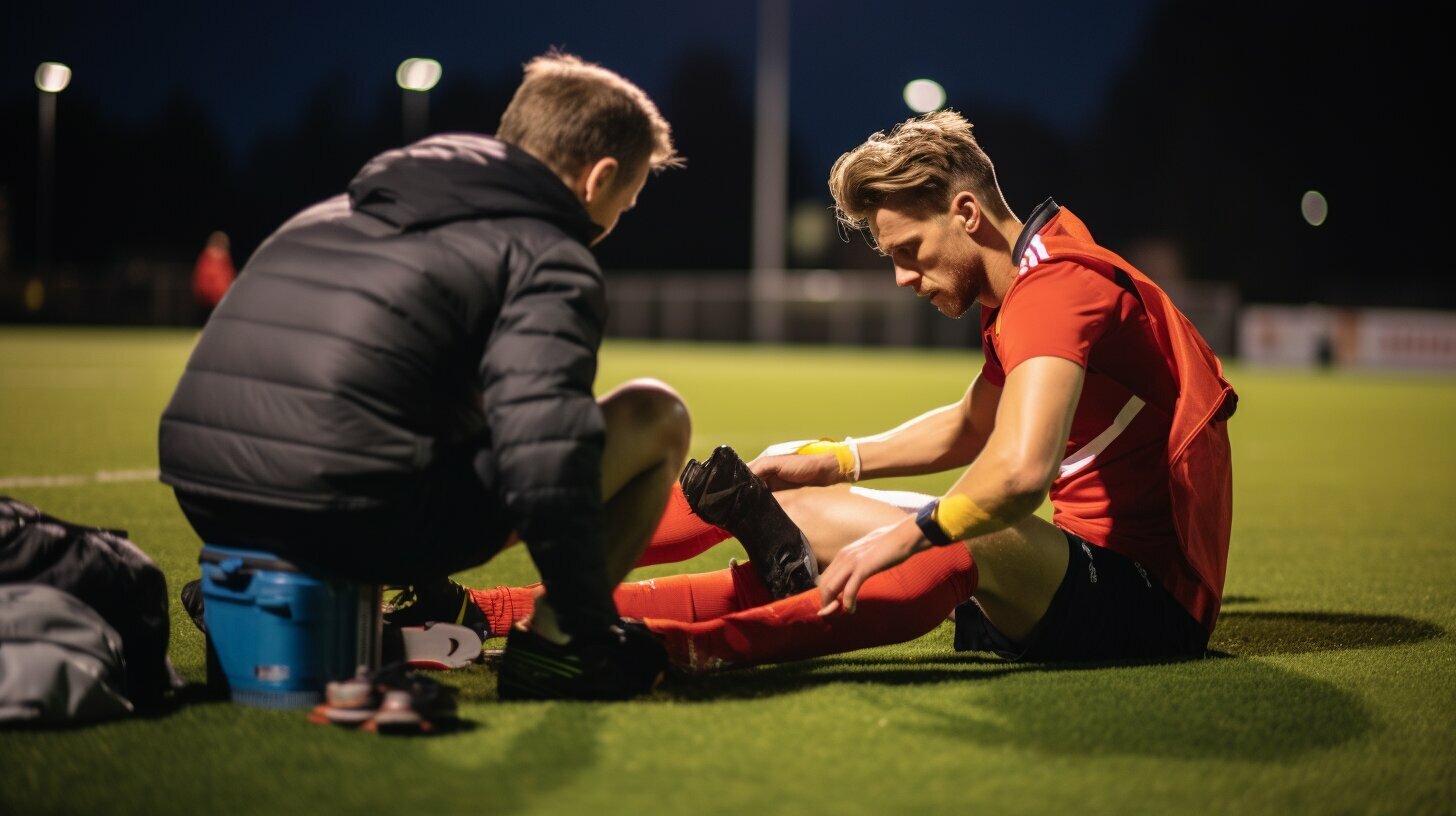
| Item | Description |
|---|---|
| Wound dressings | For covering and protecting wounds |
| Bandages | To immobilize and support injured body parts |
| Plasters | For minor cuts and abrasions |
| Tape | To secure bandages and provide support |
| Gloves | For personal protection when dealing with bodily fluids |
| Tweezers | To remove splinters or foreign objects |
| Scissors | For cutting tape and clothing |
| Wipes | To clean wounds and surfaces |
| Ice packs | For reducing swelling and providing pain relief |
| Foil blanket | For maintaining body temperature in case of shock |
Prevention Measures in Football
Implementing effective prevention measures is crucial in minimizing on-field injuries in football. By taking proactive steps to address potential risks and provide adequate safety equipment, players can enjoy the game while reducing the risk of injury. Whether it’s in youth football or professional leagues, prioritizing player safety is of utmost importance.
One essential prevention measure is the use of proper football safety equipment. This includes helmets, shoulder pads, knee and elbow pads, and mouthguards. Investing in high-quality protective gear ensures that players have the necessary support and protection during intense gameplay.
In addition to protective equipment, warm-ups and stretching exercises are vital in preparing the body for physical activity. Dynamic warm-ups help to increase blood flow and flexibility, reducing the risk of muscle strains and ligament damage. Stretching exercises target key muscle groups, improving their range of motion and enhancing overall endurance on the field.
Prevention Measures in Football:
- Utilize proper football safety equipment, including helmets, shoulder pads, knee and elbow pads, and mouthguards.
- Implement dynamic warm-up routines to increase blood flow and flexibility before gameplay.
- Incorporate stretching exercises to enhance muscle endurance and reduce the risk of strains and ligament damage.
- Ensure the playing field is well-maintained, free from hazards such as uneven surfaces or debris.
- Train coaches and players on proper tackling techniques, emphasizing safe and controlled movements.
- Encourage hydration breaks during training and matches to prevent dehydration and heat-related illnesses.
By implementing these prevention measures, the risk of on-field injuries in football can be significantly reduced. However, it is important to note that despite these efforts, injuries may still occur. Therefore, having a well-stocked football first aid kit readily available is crucial to providing prompt and effective treatment when needed.
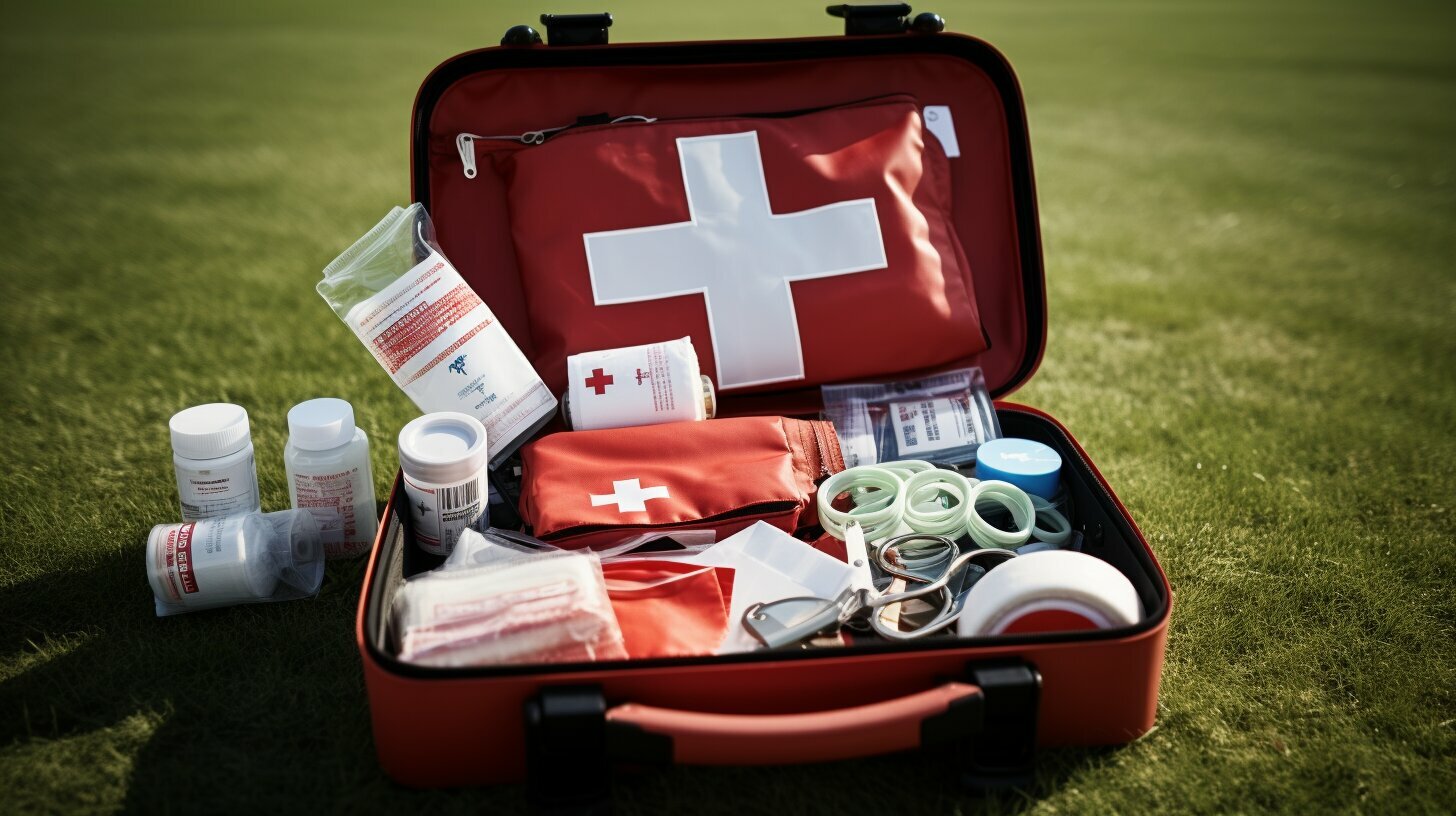
Addressing Common Risks in Football
It is important to address the most common risks in football and be prepared with the appropriate first aid equipment to handle injuries. Football is a physically demanding sport that can result in various injuries, including concussions, sprains, strains, fractures, and ligament damage. By understanding these risks and taking proactive measures, we can create a safer playing environment for football players of all ages.
One of the key steps in preventing football injuries is ensuring that players have access to a well-stocked first aid kit. This kit should contain essential items such as wound dressings, bandages, plasters, tape, gloves, tweezers, scissors, wipes, ice packs, and a foil blanket. Having these supplies readily available allows for immediate treatment and can help minimize the impact of an injury.
In addition to having the necessary equipment, it is crucial for coaches to receive education in first aid management. Knowledgeable coaches can provide better care and treatment for injured players, increasing the chances of a full recovery. Coaches should be trained in recognizing the signs and symptoms of common football injuries and understanding the appropriate steps to take in providing initial aid.
| Common Football Injuries | Prevention Measures |
|---|---|
| Concussions | Proper education on tackling techniques and the importance of head protection |
| Sprains and Strains | Thorough warm-up exercises and regular stretching routines |
| Fractures | Strengthening exercises and ensuring players wear appropriate protective gear |
| Ligament Damage | Emphasizing proper tackling and running techniques to reduce the risk of twisting injuries |
By implementing these football injury prevention measures and being equipped with a comprehensive first aid kit, we can significantly reduce the occurrence and severity of injuries on the field. It is essential for coaches, players, and support staff to work together in prioritizing player safety and providing prompt and effective care when injuries occur. Together, we can create a safer and more enjoyable football experience for everyone involved.
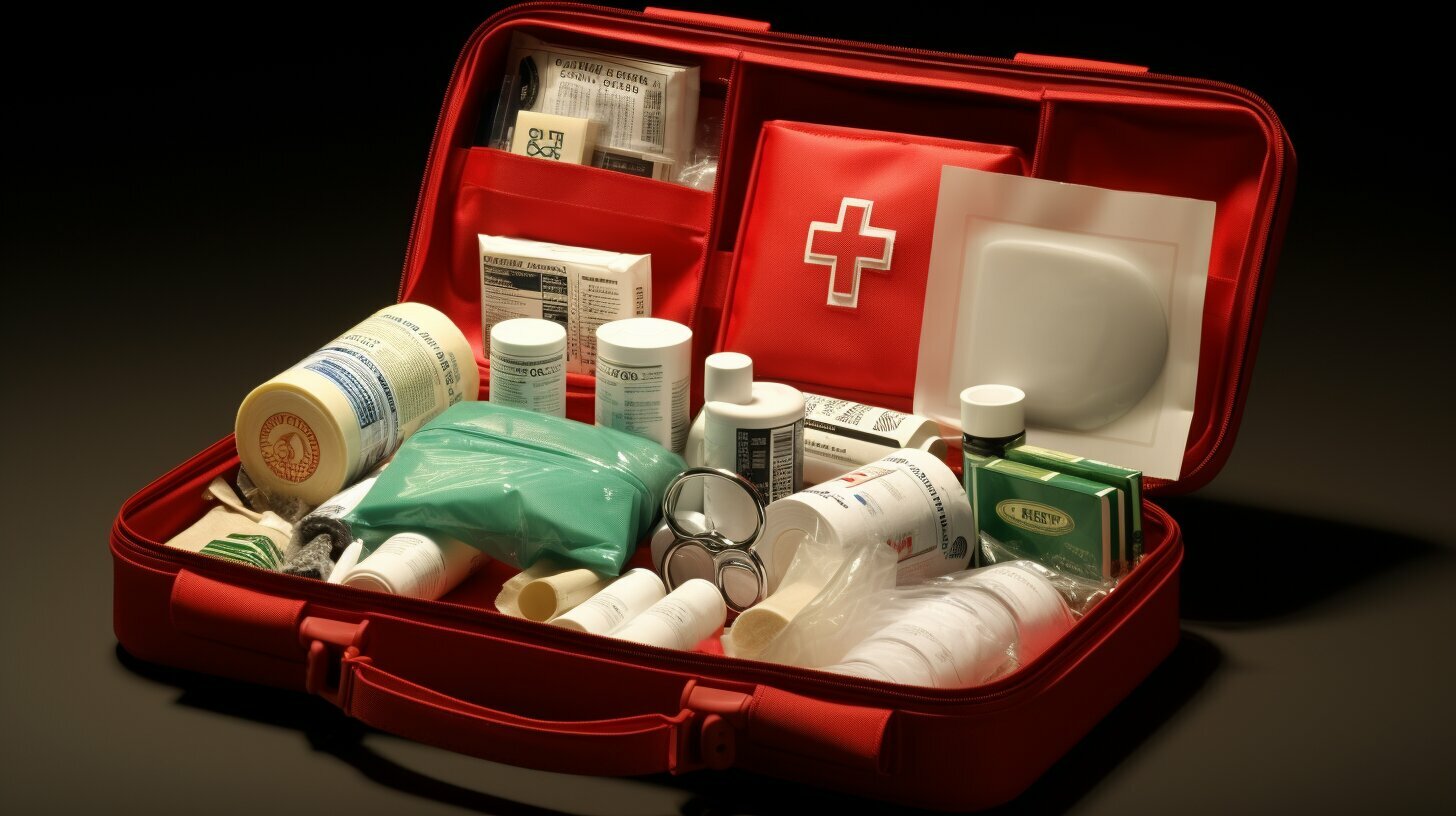
The Role of Coaches in First Aid Management
Coaches play a crucial role in effectively managing first aid on the football field, ensuring the proper care of injured players. In youth football, where deficits in first aid equipment are still prevalent, it is essential for coaches to be knowledgeable and equipped to handle common football injuries. According to a recent study, 84% of participating youth football teams had their own first aid kit, but unfortunately, the majority of these kits were insufficiently equipped. In 60% of all youth teams, coaches were responsible for using the first aid equipment, making their role in first aid management even more significant.
Common football injuries, including concussions, sprains, strains, fractures, and ligament damage, require immediate attention to ensure the well-being of the injured player. This is why it is imperative for coaches to have a well-stocked football first aid kit at their disposal. The kit should include essential items such as wound dressings, bandages, plasters, tape, gloves, tweezers, scissors, wipes, ice packs, and a foil blanket. By having access to these supplies, coaches can provide prompt and effective first aid to injured players, minimizing the risk of further complications.
In addition to having the necessary equipment, coaches should also receive education in first aid management. This ensures that they are equipped with the knowledge and skills to handle various football injuries and provide the best care possible. It is essential for coaches to understand the importance of timely treatment and be able to identify and assess injuries accurately. With proper first aid education, coaches can contribute significantly to player safety and well-being on the field.
Ultimately, the role of coaches in first aid management cannot be understated. Their quick and effective response to on-field injuries can make a significant difference in the recovery and overall safety of football players. By prioritizing proper first aid education and having a well-stocked first aid kit, coaches can play a vital role in ensuring the best possible care for injured players.
| Common Football Injuries: | Prevention Measures: |
|---|---|
| Concussions | Proper warm-ups and stretching |
| Sprains | Regular strength and conditioning exercises |
| Strains | Wearing appropriate protective gear |
| Fractures | Enforcing fair play and sportsmanship |
| Ligament damage | Maintaining well-maintained playing surfaces |
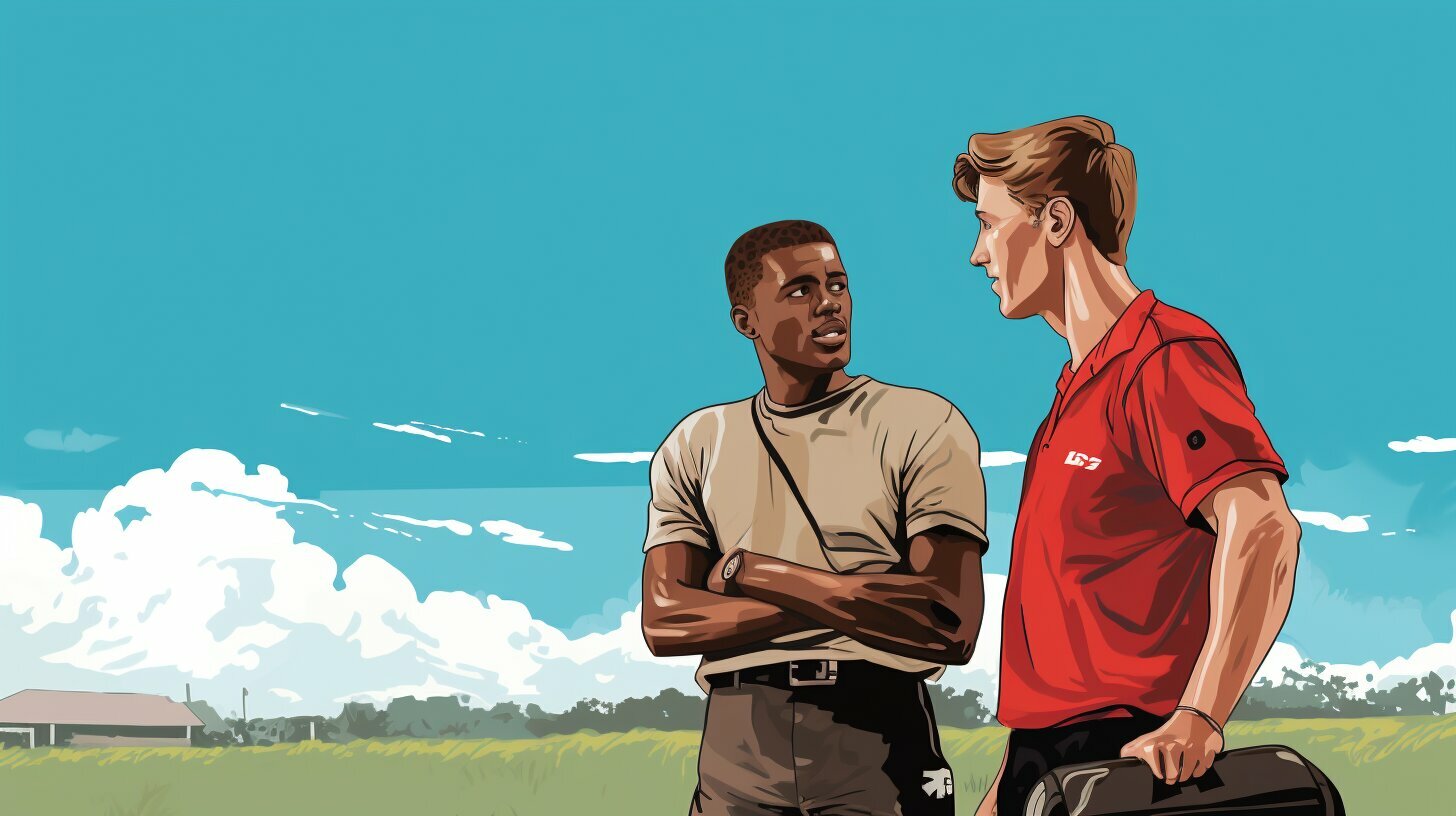
Swift and appropriate first aid treatment is essential in preventing further complications and promoting the recovery of players with on-field injuries. When an injury occurs during a football match, immediate attention is crucial to minimize the severity and duration of the injury. Timely treatment can make a significant difference in the player’s overall well-being and future performance.
One of the most common on-field injuries in football is sprains, which can lead to long-term joint instability if not treated promptly. Applying ice packs and compression to the affected area can help reduce swelling and alleviate pain. Additionally, implementing the RICE (Rest, Ice, Compression, Elevation) method within the first few minutes of sustaining an injury can expedite the healing process and prevent further damage.
Another injury that requires prompt treatment is a concussion. Concussions can have serious long-term effects on a player’s health if not managed correctly. Immediate removal from play and rest are essential steps in concussion management. Coaches and medical staff should monitor the player closely and follow concussion protocols for a safe return to play.
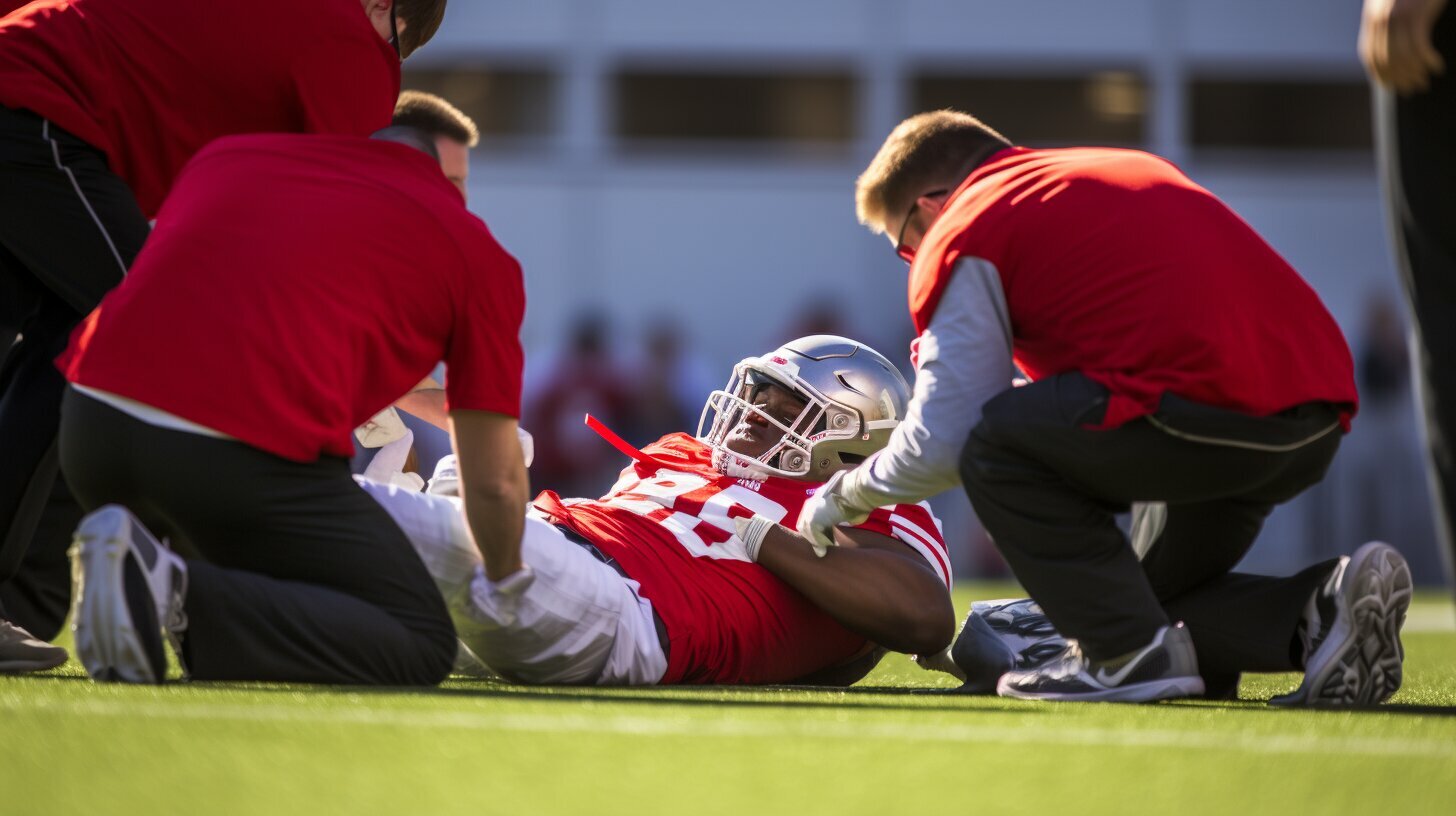
- Assess the injury and provide initial care.
- Apply appropriate first aid techniques, such as the RICE method for sprains.
- Monitor the player closely for signs and symptoms of more severe injuries, such as concussions.
- Notify medical professionals if necessary.
- Follow up with the player to ensure proper recovery.
By prioritizing and delivering timely first aid treatment, players can receive the necessary care to heal properly and return to the field safely. Coaches, medical staff, and even fellow teammates play a crucial role in providing immediate assistance to injured players. Remember, swift and appropriate first aid treatment can prevent complications and support the overall well-being of football players.
| Common Football Injuries | First Aid Techniques |
|---|---|
| Sprains | RICE method: Rest, Ice, Compression, Elevation |
| Concussions | Immediate removal from play, rest, and follow concussion protocols |
| Fractures | Immobilization and seeking medical attention |
| Ligament damage | Stabilization and seeking medical attention |
Ensuring Player Safety with a Well-Equipped First Aid Kit
By ensuring a well-equipped first aid kit, player safety can be enhanced, and the severity of injuries can be minimized. Sufficient first aid equipment is essential in treating injuries on football fields, especially in youth football where deficits in first aid on the field are still present. According to a study, 84% of participating youth football teams had their own first aid kit, but the majority of them were insufficiently equipped. Coaches were responsible for using the first aid equipment in 60% of all youth teams.
Common football injuries such as concussions, sprains, strains, fractures, and ligament damage require immediate attention and proper treatment. That’s why having a well-stocked football first aid kit is crucial. It should include essential items like wound dressings, bandages, plasters, tape, gloves, tweezers, scissors, wipes, ice packs, and a foil blanket. These supplies enable coaches and medical personnel to respond promptly and effectively to on-field injuries, reducing the risk of complications and ensuring the well-being of the players.
Prevention measures, such as proper warm-ups and stretching routines, play a vital role in minimizing the occurrence of injuries. However, when accidents happen, having the necessary first aid equipment is essential for immediate care. Addressing the most common risks in football, such as head injuries and joint sprains, requires quick intervention, and a well-equipped first aid kit provides the tools to do so. Coaches, who play a crucial role in player safety, should also receive education in first aid management to ensure they can provide proper care and assistance when needed.
Image
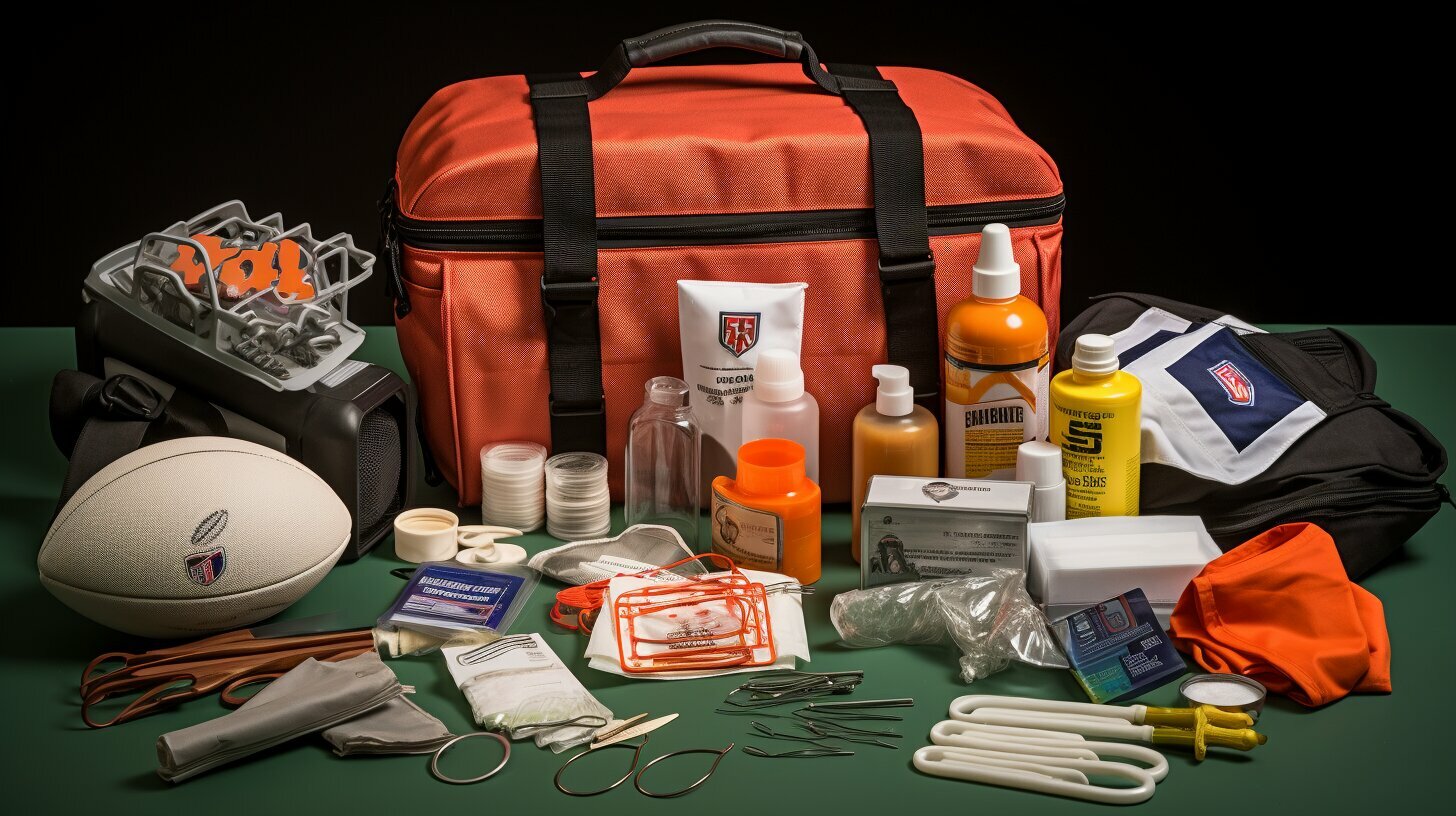
By prioritizing the availability of a well-equipped first aid kit, football teams can create a safer playing environment for their players. Whether it’s a minor cut or a potentially serious injury, being prepared with the necessary supplies can make all the difference in providing immediate care and preventing further harm. Player safety should always be a top priority in football, and a well-stocked first aid kit is an essential component in achieving this goal.
| Benefits of a well-equipped first aid kit: |
|---|
| Immediate response to on-field injuries |
| Minimization of injury severity |
| Reduced risk of complications |
| Promotion of player safety |
| Assistance in quick and effective treatment |
Conclusion
In conclusion, a well-stocked football first aid kit is essential in reducing on-field injuries, and it is important for coaches and teams to prioritize player safety by having the necessary equipment and knowledge for first aid management.
Factual data shows that sufficient first aid equipment is crucial for treating injuries on football fields. However, deficits in first aid on the field are still present, especially in youth football. A study found that 84% of participating youth football teams had their own first aid kit, but the majority of them were insufficiently equipped. Coaches were responsible for using the first aid equipment in 60% of all youth teams.
Common football injuries include concussions, sprains, strains, fractures, and ligament damage. To effectively manage these injuries, it is important to have a well-stocked football first aid kit that includes essential items such as wound dressings, bandages, plasters, tape, gloves, tweezers, scissors, wipes, ice packs, and a foil blanket.
In addition to having the necessary equipment, prevention measures such as proper warm-ups and stretching should be implemented. Furthermore, coaches should receive education in first aid management, as their knowledge and quick intervention can significantly improve player care and contribute to overall player safety.
By addressing common risks in football and ensuring timely treatment, a well-equipped first aid kit plays a vital role in promoting player safety. With the right equipment and knowledge, coaches and teams can effectively manage on-field injuries and reduce their severity, leading to a safer and more enjoyable football experience for all.
